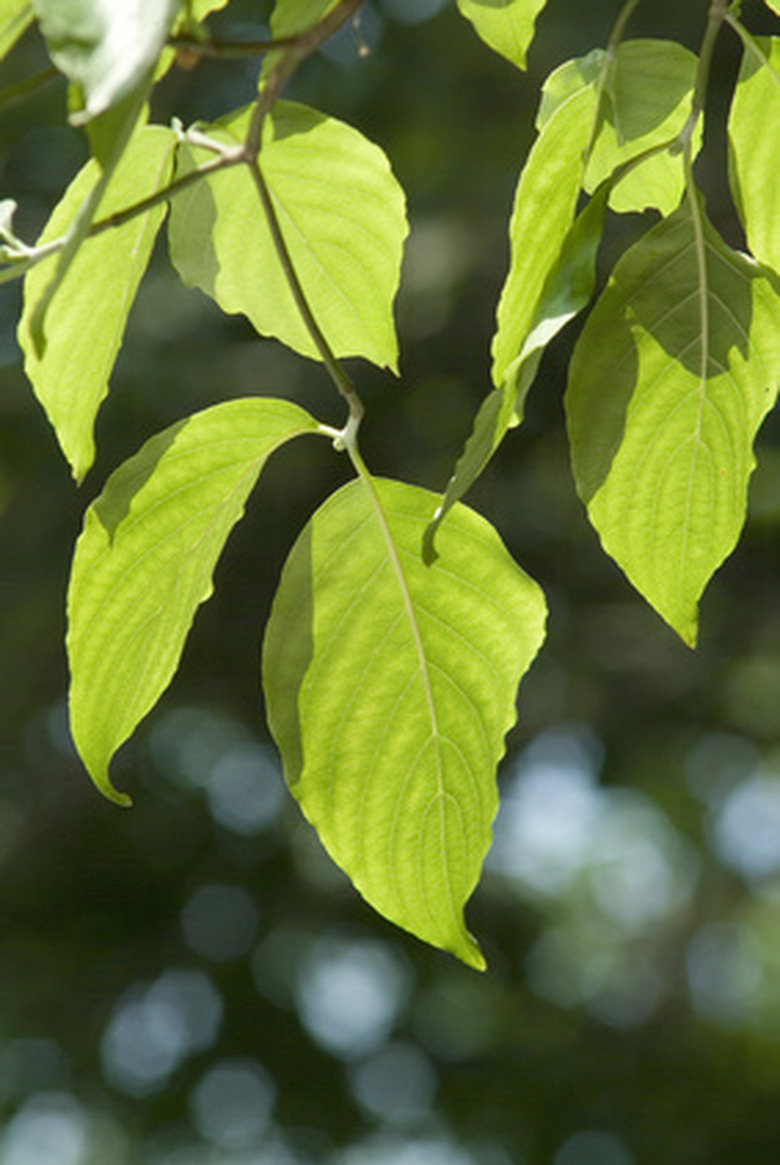Dogwood Tree Leaf Identification
Of the five types of trees from the dogwood family (Cornaceae) that have large distributions through portions of the United States, the red-osier dogwood has the largest range. Other types of dogwoods that grow native to North America include flowering dogwood, Pacific dogwood, alternate-leaf dogwood and rough-leaf dogwood. The identification of the leaves of dogwood trees hinges on recognizing subtle differences in their features.
Length
The lengths of dogwood tree leaves have some variation between species. The Pacific dogwood has the longest leaves, with the average leaf in the 4- to 6-inch-long range. The red-osier dogwood and rough-leaf dogwood leaves fall between 1.5 and 3.5 inches long, with alternate-leaf dogwood slightly larger, some making it to lengths of 4.5 inches. The flowering dogwood leaf can grow to 5 inches in length.
- Of the five types of trees from the dogwood family (Cornaceae) that have large distributions through portions of the United States, the red-osier dogwood has the largest range.
- The Pacific dogwood has the longest leaves, with the average leaf in the 4- to 6-inch-long range.
Width
Pacific dogwood has the widest leaves of the American dogwoods, with the typical leaf in the 1.5- to 3-inch wide range, according to "Trees of North America." Flowering dogwood is next in terms of width, with some leaves 2.5 inches wide. Rough-leaf, alternate-leaf and red-osier dogwood leaves seldom exceed 2 inches in width; red-osier dogwood leaves can be as narrow as just 5/8ths of an inch.
Opposite and Alternate
The leaves grow opposite each other on the twigs on these types of dogwoods. The one notable exception is the alternate-leaf dogwood tree. On these, the leaves grow in an alternate manner on the twigs. One leaf occurs at each node on the limb, rather than two emerging across from one another as in the other dogwood species.
Colors
Dogwood leaves help to make the trees popular as ornamentals because of their colors. The leaves of dogwoods possess a green upper surface, with the underneath surface of the leaves having a much paler appearance. In the fall, dogwood leaves add to the charm of the tree by changing to bright colors. Flowering dogwoods, Pacific dogwoods, red-osier dogwoods and rough-leaf dogwoods turn red. The alternate-leaf dogwood leaves change to reds and yellows.
- Pacific dogwood has the widest leaves of the American dogwoods, with the typical leaf in the 1.5- to 3-inch wide range, according to "Trees of North America." Rough-leaf, alternate-leaf and red-osier dogwood leaves seldom exceed 2 inches in width; red-osier dogwood leaves can be as narrow as just 5/8ths of an inch.
Features
The main veins in dogwood leaves curve upward, with the veins typically running parallel to the edges of the leaves. The "National Audubon Society Field Guide to Trees" says that dogwood leaves have no apparent teeth along their edges, but when you take a magnifying lens and make a much closer inspection, you will discover tiny serrations. Dogwood leaves are smooth above and below, except for the aptly named rough leaf-dogwood. This kind has stiff hairs present on the upper part of the leaf and softer ones beneath that give the underside a woolly texture.
References
- Ohio Department of Natural Resources: Flowering Dogwood
- "National Audubon Society Field Guide to Trees"; Elbert Little; 2008
- "Trees of North America"; C. Frank Brockman; 1996
